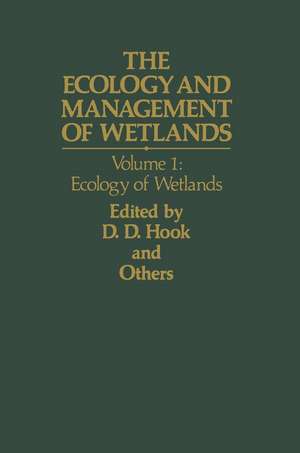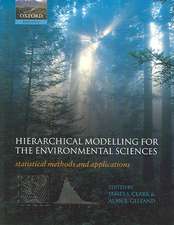The Ecology and Management of Wetlands: Volume 1: Ecology of Wetlands
Autor Donal D. Hook, W. H. McKee Jr, H. K. Smith, James Gregory, V. G. Burrell Jr, M. Richard DeVoe, R. E. Sojka, Stephen Gilbert, Roger Banks, L. H. Stolzy, Chris Brooks, Thomas D. Matthews, T. H. Shearen Limba Engleză Paperback – 18 mai 2012
Preț: 656.25 lei
Preț vechi: 772.05 lei
-15% Nou
Puncte Express: 984
Preț estimativ în valută:
125.57€ • 131.46$ • 103.90£
125.57€ • 131.46$ • 103.90£
Carte tipărită la comandă
Livrare economică 07-21 aprilie
Preluare comenzi: 021 569.72.76
Specificații
ISBN-13: 9781468483802
ISBN-10: 1468483803
Pagini: 620
Ilustrații: XXV, 592 p.
Dimensiuni: 155 x 235 x 33 mm
Greutate: 0.86 kg
Ediția:1988
Editura: Springer Us
Colecția Springer
Locul publicării:New York, NY, United States
ISBN-10: 1468483803
Pagini: 620
Ilustrații: XXV, 592 p.
Dimensiuni: 155 x 235 x 33 mm
Greutate: 0.86 kg
Ediția:1988
Editura: Springer Us
Colecția Springer
Locul publicării:New York, NY, United States
Public țintă
ResearchCuprins
I. The Resource.- 1. Global Wetlands — History, Current Status and Future.- 2. The Functions of a Pristine Estuarine Ecosystem.- 3. Aquatic Animal Production and Wetland Relationships: Insights Gleaned Following Wetland Loss or Gain.- River Regulation Effects on Floodplain Hydrology and Ecology.- 5. Expertise in Wetlands Research and Management: The Need and Some Priorities for North-South Transfer.- II. Hydrologic and Water Quality Values of Wetlands.- 6. A Review of the Recharge-Discharge Function of Wetlands.- 7. Some Comments on the Relation Between Ground Water and Wetlands.- 8. Water Quality Functions of Wetlands: Natural and Managed Systems.- 9. Analysis of Flood Peak Moderation by Depressional Wetland Sites.- 10. Physical and Biological Control of Mangrove Pore Water Chemistry.- 11. The Value of Wetlands in Low Relief Landscapes.- 12. Wetland Evapotranspiration in Temperate and Arid Climates.- 13. Role of Coastal Marshes in Energy Dissipation and Shore Protection.- 14. Ground-water and Surface-water Interactions in Minnesota and Wisconsin Wetlands.- III. Biological Values of Wetlands.- 15. Wetlands and Their Relationship to Migrating and Winter Populations of Waterfowl.- 16. Aquatic Habitats of Breeding Waterfowl.- 17. Coastal Wetlands — Major Ecological Entities for Wading and Shore Birds.- 18. Mammals and Wetlands.- 19. Endangered, Threatened and Rare Wetland Plants and Animals of the Continental United States.- 20. Aquatic Invertebrates of Freshwater Wetlands: Function and Ecology.- IV. Formation, Chemistry and Biology of Wetland Soils.- 21. Soil Formation Under Hydromorphic Conditions.- 22. Characterization and Origin of Delmarva Bay Basin Fill.- 23. Gas Exchange and Atmospheric Properties of Flooded Soils.- 24. Chemistry of Metals and Trace Elements ina Submerged Soil.- 25. Phosphorus Transformations in Flooded Soils.- 26. Carbon and Nitrogen Dynamics in Wetland Soils.- 27. The Influence of Redox Potential on the Environmental Chemistry of Contaminants in Soils and Sediments.- 28. Wetland Soils with High Sulfide Contents.- 29. Soil Nitrogen, Phosphorus and Organic Carbon in Transplanted Estuarine Marshes.- V. The Tolerance of Plant Species to Wetland Sites.- 30. Biochemical Adaptations to Anoxia in Barnyard Grass.- 31. Involvement of the Hormones Ethylene and Abscisic Acid in Some Adaptive Responses of Plants to Submergence, Soil Waterlogging and Oxygen Shortage.- 32. Nutrient Uptake and Acclimation to Soil Waterlogging and Oxygen Shortage in Non-wetland Plants.- 33. Cytoplasmic Acidosis and Flooding Tolerance in Crop Plants.- 34. The Relationship of Soil Parameters and Root Metabolism to Primary Production in Periodically Inundated Soils.- 35. Mineral Nutrition of Oxygen-stressed Crops and its Relationship to some Physiological Responses.- 36. Responses of Woody Seedlings to Elevated Flood Water Temperatures.- 37. Ultrastructure Studies as a Means of Evaluating Plant Tolerance to Flooding.- 38. Use of Oxygen Microelectrodes to Measure Aeration in the Roots of Intact Tree Seedlings.- 39. Flood Tolerance Indices for Palustrine Forest Species.- 40. Interspecific Genetic Variation of Loblolly Pine Tolerance to Soil Waterlogging.- VI. Estuarine Wetlands and Interactions Among Their Components.- 41. Pathways and Controls of the Carbon Cycle in Salt Marshes.- 42. Irregularly Flooded Salt Marshes of the Gulf and Atlantic Coasts of the United States.- 43. A Comparison of Vascular Plant Communities in Tidal Freshwater and Saltwater Marshes.- 44. Herbivore Population Dynamics in Intertidal Marshlands: The Role of Host Plant Nutrition.- 45. The Utilization of Seagrass Meadows by Fishery Organisms.- 46. A Comparison of Fish and Invertebrate Community Composition in Tidal Freshwater and Oligohaline Marsh Systems.- 47. Pattern and Process in Arid-region Salt Marshes — Southern California.















